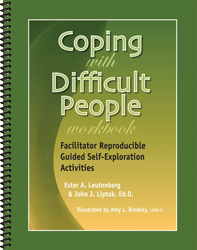 by Dr. John J. Liptak and Ester A. Leutenberg
by Dr. John J. Liptak and Ester A. Leutenberg
Difficult people are everywhere. Difficult people are those who frustrate us to no end. (In fact, others may view each of us as a difficult person.) We encounter difficult people at home, in the workplace, school, grocery market, anywhere. Often how much they affect us depends on our self-esteem, ability to recognize “hot buttons” and effectiveness of communication skills.
This book teachs a specific model that participants can use to build positive relationships with difficult people.
Full Description:
Facilitator Reproducible Guided Self-Exploration Activities
Difficult people are everywhere. Difficult people are those who frustrate us to no end. (In fact, others may view each of us as a difficult person.) We encounter difficult people at home, in the workplace, school, grocery market, anywhere. Often how much they affect us depends on our self-esteem, ability to recognize “hot buttons” and effectiveness of communication skills.
Because participants will encounter difficult people in all aspects of their lives, it is important for them to learn a way of dealing with them. In this book, Coping with Difficult People Workbook, we teach a specific model that participants can use to build positive relationships with difficult people.
The Coping with Difficult People Workbook contains assessments and guided self-exploration activities that can be used with a variety of populations to help participants learn to cope more effectively with difficult people. Each chapter of this workbook begins with an annotated Table of Contents with notes and examples for the facilitator. Each chapter contains two primary elements: 1) A set of assessments to help participants gather information about themselves in a focused situation, and 2) a set of guided self-exploration activities to help participants process information and learn effective ways of coping with the difficult people they encounter.
Activities are divided into four chapters to help you identify and select assessments easily and quickly:
Chapter 1: Types of Difficult People – This chapter helps participants identify and learn about the various types of difficult people they may encounter.
Chapter 2: Communicating with Difficult People – This chapter helps participants learn their strengths in communicating, and learn more effective ways of communicating with difficult people in their lives.
Chapter 3: Coping Skills – This chapter helps participants explore how well they are coping with difficult people, and learn some alternative techniques for ways to cope.
Chapter 4: Assertive Confrontation Style – This chapter helps participants explore their style in confronting difficult people, and learn effective confrontational tools and techniques.
All of the guided activities are fully reproducible for use with your clients/participants.
Coping with Difficult People Workbook
92 pages 8 1/2"x11"
Stock: Usually ships in 10-12 business days!
|